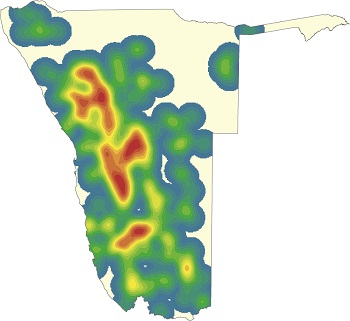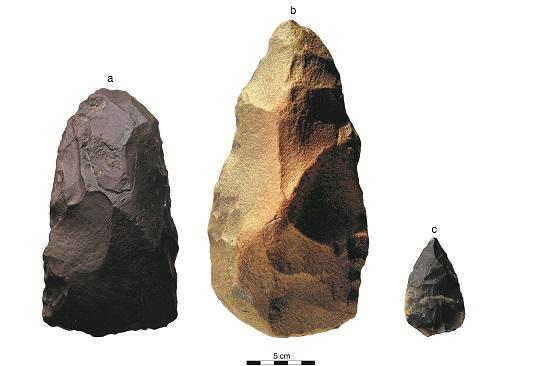Shards of history illustrated
The oldest Namibians
Archaeological sites provide snapshots of the past, showing where people have lived at different times. Artefacts and environmental evidence found at these sites also provide clues as to how they once lived. Evidence collected worldwide suggests that hunting and gathering has been the dominant lifestyle for much of human history, and that pastoral nomads and crop farmers emerged only in the last few thousand years. It is often believed that the occupants of archaeological sites in Namibia were San people.2 While the genetic lineage of the San is thought to be 100,000–150,000 years old3, no-one really knows what languages were spoken or how these ancient ancestors were related to any present-day groups.
9.01 Relative densities of archaeological sites occupied during different times4
1.8 million – 10,000 years ago

10,000–2,000 years ago

Less than 2,000 years ago


These maps show the distribution and relative concentrations of archaeological sites found from different periods of Namibia's prehistory. Most sites are in the western, southern and central rocky and more arid areas of the country, which are currently sparsely populated; paradoxically few sites have been found in the wetter northern and eastern more productive areas where most rural Namibians live today. It seems unlikely that major changes in the distribution of rural Namibians have occurred, although western Namibia may have been wetter and supported more people 12,000 years ago during the early Holocene period than nowadays.5 It is more likely that artefacts – including rock paintings – have been better preserved and have been easier to find in the rocky and more arid areas of southern and western Namibia. More archaeological field research has also been done there than elsewhere in Namibia. Additionally, many places previously occupied by people have probably been covered by Kalahari sands in the east and north, but also by Namib sands in the far west.
The earliest and longest period, between about 1.8 million and 10,000 years ago, illustrated here (first map above) falls within much of the Pleistocene geological period and Stone Age. Numerous stone tools have been found at many sites in Namibia, some of which could be dated reliably to their origins several hundred thousand years ago. It was towards the end of this period that the first rock art was produced in Namibia. Little can be surmised about how these early Namibians lived, other than they hunted and gathered food using stone tools that became more sophisticated over the millennia. Undoubtedly, they moved extensively following sources of water and food that came and went with the seasons, and with drier or wetter climate cycles.
Between 10,000 and 2,000 years ago (second map above), Namibians continued to live by hunting and gathering, but used a greater range of tools including arrows, spears, grindstones and tools for digging and scraping. The first evidence of trade comes from this period, suggesting widespread movement and connections with people elsewhere in addition to journeys in response to changes in the availability of food and water.
It is during the last 2,000 years (last map above) that farming of crops and livestock started, representing a major change in the livelihoods of people settling in places suited to agricultural production. Technical innovations included pottery and metalworking. Copper smelting was one form of metalwork, and many smelting sites have been found close to the Matchless Belt; copper was also extracted from the hills around Tsumeb and Otavi. While crop cultivation was largely limited to northern Namibia, livestock farming was much more widespread.

Photo: P van Schalkwyk
Circles of stones, thought to mark the walls of shelters used by people when they foraged in and around the Namib long ago.

Photo: P Breunig
Stone tools were made and used for hundreds of thousands of years by Namibia's first inhabitants. The three stone tools shown here would have had different uses: (a) this cleaver, found in the Brandberg area, has sharp edges and was probably used for cutting meat, skins and plants; (b) the hand axe with its pointed tip and broad bottom from the Huib-Hoch Plateau in southwestern Namibia, was probably used to break bones to get to their marrow, among other uses; (c) spearheads were attached to wooden shafts to form spears, one of mankind's earliest long-distance weapons.

Photo: H Denker
This fossil is the lower jaw of a hominoid primate named Otavipithecus namibiensis that lived some 13 million years ago near Berg Aukas, close to Grootfontein. Otavipithecus belonged to the line of primates that eventually evolved into present-day great apes and humans. This fossil find in 1991 generated international interest, as it helps to piece together the patchy evolutionary history of primates.

